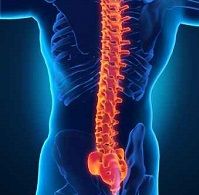Article
Aging Spine: So Many Ailments They Need a New Name
Author(s):
There are so many problems associated with the aging spine in older people that Canadian researchers want to coin a new term to cover them, called "degenerative cervical myelopathy."

A range of disorders, diseases, and dysfunctions can cause problems with the spine. Lindsay Tetreault, HBSc, of the Division of Neurosurgery and Spine Program at Toronto Western Hospital, along with several colleagues reviewed the any degenerative spinal disorders that lead to progressive cervical spinal cord compression, and have proposed a new term: degenerative cervical myelopathy (DCM). Their review was published in Neurosurgery in October 2015.
The authors of this review suggest that there is a need to standardize the nomenclature in order to better define CSM, and agree with a previous proposal to adopt the term degenerative cervical myelopathy, which would include “osteoarthritic changes to the spine, including spondylosis, disk herniation, and facet arthropathy, as well as ligamentous hypertrophy, calcification, or ossification.”
As people age, the spine changes. As a result of the degeneration of the disks, the spinal canal narrows and begins to compress the spinal cord. According to the authors, “Chronic mechanical compression of the cord causes a flattening and widening of the spinal cord and results in a cascade of pathophysiological events, including ischemia, endothelial cell impairment, disruption of the blood-spinal cord barrier, neuroinflammation, and apoptosis.”
Even people who are asymptomatic are likely to have some degenerative changes, particularly after the age of 60. Another prevalent condition is ossification of the posterior longitudinal ligament, which is nearly always accompanied by other degenerative changes. These conditions are generally diagnosed through clinical assessment, imaging, or electrodiagnosis.
Not everyone who experiences spinal degeneration follows the same pattern. “The pattern of progression in DCM is highly variable and not well defined. Some patients with radiologic spondylosis will remain clinically stable over time, whereas others, once symptomatic, will progress rapidly to advanced clinical myelopathy.” Various studies have attempted to determine whether or not there are clinical predictors that can reveal how the disease will progress, with varying results.
Physical therapy, drugs, injections, traction , and surgery are all commonly used to treat DCM. Multiple studies have been conducted to determine whether conservative or surgical approaches work best, with conflicting results. The authors conclude, “The ageing spine undergoes natural degenerative changes that are unique to each individual.” Even though there are many diagnostic entities, the authors believe this review provides “further rationale and support for describing the spectrum of degenerative spine conditions under the overarching term degenerative cervical myelopathy.”





